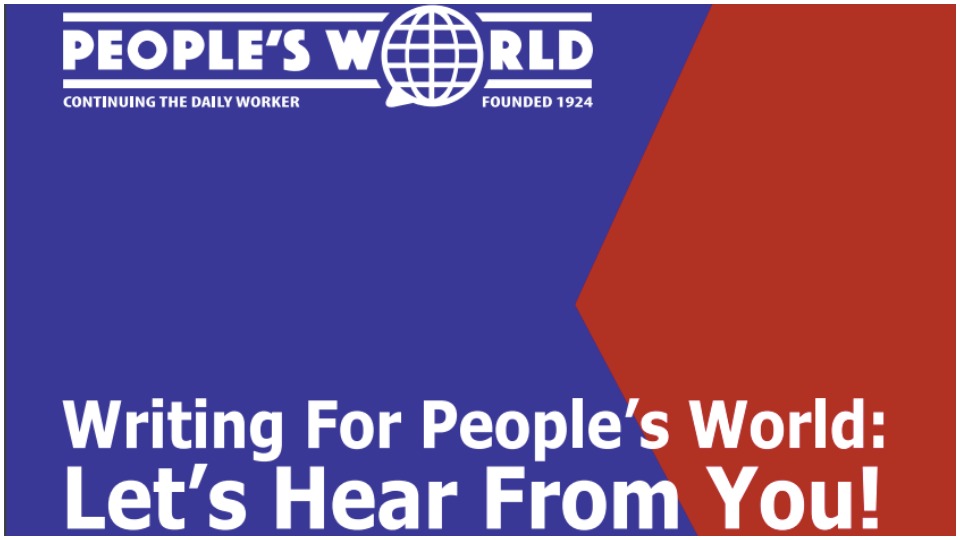
You read People’s World. Have you ever thought of writing an article for us? Let’s have a little chat about that.
All writers, journalists, historians, novelists, even poets, tell stories. By the power of your words, you not only bring the reader from Point A to Point B—you’ve also made a point!
Writing for People’s World is no different, except that we are a class-conscious and socially conscious publication that always takes the people’s side. Whether we report on labor, the environment, politics, or culture, we always ask how working people, women, Indigenous, Black, Latinx, immigrants, and other oppressed groups are represented in the story. Even if we are recording a setback in the people’s struggle, such as an important election lost or a strike that failed, we look ahead to signs of progress and hope. We do not despair, because we have an important job ahead of us: We have a world to win!
Our small staff can’t be everywhere at once, so we rely on people across the country and all over the world to share their stories about what’s going on in their neighborhood. That’s where you come in.
What to write about?
Your choice of subject says a lot about you as a writer. Sometimes you make a conscious decision to go out and meet workers on a picket line, or community members fighting toxic emissions from a nearby refinery, or see a film or play that has a lot of social relevance. Maybe you want to share a book you’ve just read by reviewing it.
Other times, a story subject comes to you: You happen across a little pocket park in your town named for someone active in the local civil rights movement. Or you’re watching your neighbor as she rips up her water-guzzling lawn. She’s gathered a group of high school kids to research and plant a no-pesticide garden of low water usage native species that attract bees, birds, and butterflies, and that group is now consulting for other homeowners. Wow, you think, that would make a great story!
Any story requires research—interviews, reading official reports, attending public meetings, maybe some backgrounding on the internet to see what else has been written about the subject. Before you invest a lot of energy into it, it might be a good idea to query People’s World editors as to the story’s suitability and timeliness, and ask for advice or contacts they might be able to offer. It could be that just that morning they received an excellent piece on that same subject! You can make a query by writing to editors@peoplesworld.org.
When you’re conducting an interview, or attending a public meeting, keep your ear tuned for some good quotes. Listen for the poetry, expressiveness, and color of ordinary people’s speech, and get some information about the speaker—name, age if relevant, where they’re from, and their connection to the story.
Take high-resolution photos (an iPhone works well) and submit from one to four with your article. Focus on people, action, faces, hands. Try an unusual angle, and also try to avoid a lineup of heads sitting behind a table on a panel. Boring! Give us photos that tell stories equal in power to the story you’re writing.
Putting pen to paper (or fingers to keyboard!)
Your headline is important, and consider writing that first: It will sum up in fewer than 12 carefully chosen words what your story is about and guide a visitor to the People’s World homepage toward your article. Writing it first can help you organize your own thinking so that you know from the outset where you’re heading with this story. Our editors may end up altering the headline later, but making up your own is a good place to start.
Then put your name—your byline—on the next line. Psychologically that sets you up as the author who has something vital to tell the world, proud to put your name on the words and ideas you’re about to set down. (A footnote to that: If you’re writing a piece as a whistleblower insider and don’t care to get fired from your job just now, or in other similar cases that require discretion, we do allow writers to use a pen name.)
Many writers find that making an outline of the story helps them organize all the information and quotes they’ve gathered. Use a computer to write on if possible: That way you can effortlessly improve a word choice, correct spelling, or move a paragraph.
Perhaps you’ll benefit from this advice: Don’t think of yourself as a Writer with a Capital W, as if you will be compared to Jane Austen or Hemingway or James Baldwin. No, just put your ideas down, keep adjusting and fine-tuning them, adding and subtracting words and thoughts as you proceed. You’re never really “Writing” (with that imposing Capital W), but always simply tinkering and revising. This might take away the terror some people can feel looking at the blank screen or page and wondering how to fill it perfectly.
Aim for an eye-grabbing first sentence or paragraph that announces the theme of your article: “Residents of Gopher Gulch woke up last Thursday morning to a revolting smell that permeated the east end of town.” And if you’re there on the scene, start off with a dateline—GOPHER GULCH, Nev.—that tells the reader, Hey, People’s World actually went there to get this story for us! An opinion piece or book review would not generally call for a dateline unless it was specifically related to that place and you were there.
End with a summation that expresses the essence of the story. “The court ordered the refinery closed until further notice, but the people of Gopher Gulch will not be satisfied until criminal charges are brought against CEO George Bushwattle. Public interest lawyers are now taking depositions for the case.”
Bad sources, good sources, better sources
Be careful with sources! Try to rely on reputable ones, and cite them accurately with attribution. You can paraphrase (that is, restate in your own words) other writing to draw out its facts and information, but if you use someone else’s exact words, then please employ “quotation” marks around them. We don’t want to be accused of plagiarism! If someone gave you some good ideas or helpful leads, it’s gracious to acknowledge them, even if it’s simply, at the end, “Rondelle Patterson contributed to this story.”
One advantage electronic publishing has over print is its ability to provide helpful links. You may want to refer to an individual or a subject without going into great depth, but if you provide a link to a well written article or a useful website, readers will appreciate that you gave them more than they expected. Links to videos of speeches, performances, news stories, or the trailer to a movie, are especially good for filling out your story with visual and aural material that goes far beyond the written word.
Read it, and read it again
When you feel you are finished with your story, read it aloud to yourself to hear how it sounds. Does it flow? Does one idea naturally lead to the next? Did you omit a word you heard in your head but neglected to write?
Did you spell the CEO’s name Bushwattle in paragraph 3 and Bushwattie in paragraph 8? You are the expert on this—our editors won’t necessarily be familiar with that name and won’t know which one is correct.
Read it again for grammar as best you can but don’t get obsessive about it. Sometimes academically correct is simply not the best and most effective writing. We don’t all need to sound like Winston Churchill.
The thing about grammar and punctuation, though, is not that we love rules simply for the sake of rules, but that any time the reader stumbles across an open quote mark that doesn’t have a close quote, a misplaced comma or misspelling, or a plural subject with a singular verb, it throws them off course and interrupts their attention to your moving and informative story.
Hit send
Now hit that send button and submit your article either to the collective editors as mentioned above, or perhaps to the one editor who answered you to say they’d like to be your contact going forward with this piece. (Speaking of “correct” grammar, notice how I said “they” to refer to the editor—who could be a she, a he, or a they—because in current speech “they” is an acceptable alternative to the clumsier “he, she, or they.” Language is a living, changing phenomenon.) Keep in mind that submission is no guarantee of publication. People’s World receives a large number of submissions, and while we strive to respond to every one, it is not always possible.
Don’t forget to send your photos. By the way, our format requires that the lead photo on each article be a horizontal (landscape), but for additional photos in the body of the article, verticals can be used. We need a caption and photo credit for each one. My editors will kill me for saying this, but yeah, sometimes you just don’t have a photo for your story, or can’t get one for some reason. In cases like that, our production manager has to read through your whole story and see if they can find some usable image in the public domain that will appropriately enhance what you have written—and it may not be what you imagined. Please don’t quote me on that.
Your editor will work with you from there. They will directly submit it for publication, but be aware that an editor edits, so they might fix a spelling mistake or break up a too long paragraph or eliminate some unnecessary repetitiousness without consulting you. They also might get back to you with more substantive questions about things that seem unclear or that could be developed further, so you might need to give your article one more revision.
And then, upon publication, the first thing you do is read your piece on the People’s World homepage to see if everything is accurate, both in content and formatting. If you see anything that needs a correction, let us know right away. And then blast your article all over kingdom come through every platform known to the universe! And start thinking about your next piece.
Written by Eric A. Gordon
Graphics and original pamphlet design by Xian L. Olavarria.







